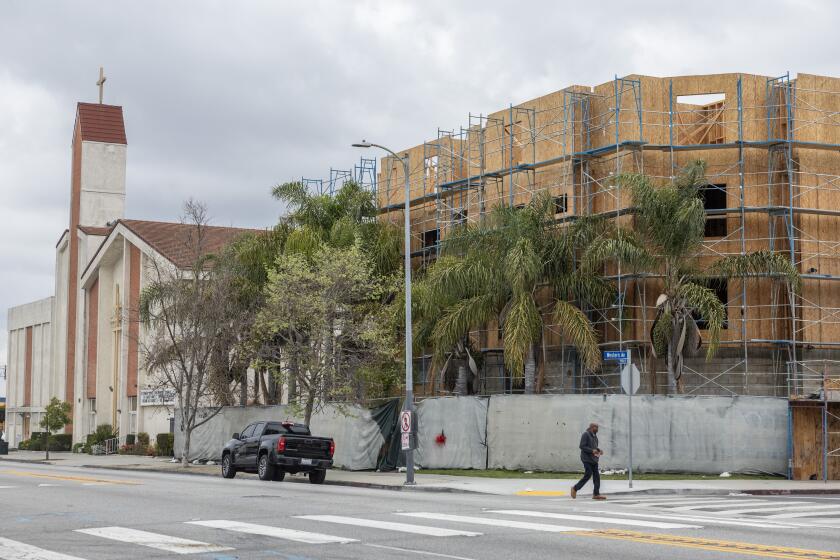Op-Ed: Why is the world of architecture so male-dominated?

Influential Iraqi-British architect Zaha Hadid poses for a photo during the opening ceremony of the National Museum of 21st Century Arts (MAXXI), in Rome, Italy in 2010. Hadid died last month at age 65.
Architecture remains a tough profession for women to crack. In the United States, even though nearly half of architecture school graduates are women, only 18% of licensed practitioners are women. Confronted with lower salaries, given fewer career-building opportunities and lacking mentors, female architects leave the field in disturbingly high numbers.
How bad is it? In medicine and law, other historically male disciplines, one-third of practitioners are women — nearly twice the rate of architects. Architecture is also overwhelmingly white. According to the University of Cincinnati’s Directory of African American Architects, fewer than 2% of licensed architects in the United States are African American.
Full-time female architects today still earn 20% less than male architects, according to the U.S. Bureau of Labor Statistics.
This homogeneity is out of step with the nation’s increasingly diverse population, particularly in urban centers. Users of architecture — whether individuals, families or communities — are diverse in their needs and deserve to be served by a profession that is equally rich in its views and practices.
For more than 130 years, women have been trying to secure a foothold in architecture. In 1879, Mary Louisa Page became the first woman in North America to graduate with an architecture degree. Nonetheless, many architecture schools refused to admit women until the 1972 passage of Title IX, which forbade gender discrimination in federally funded education programs. Those who persisted found employers skeptical of their skills and doubtful that they could exercise authority on the building site. Bosses also presumed women would quit after marrying, which somehow justified paying them a pittance compared with male colleagues.
Today, deeply entrenched biases remain. In a recent survey of women in architecture, 75% of female respondents reported having experienced sexual discrimination on the job.
The survey found 83% of women believed that having a child would disadvantage their careers. Full-time female architects today still earn 20% less than male architects, according to the U.S. Bureau of Labor Statistics.
Newly formed advocacy groups, such as Equity by Design and ArchiteXX, are making concerted efforts to remove these persistent professional obstacles with symposiums, workshops and research into retaining female talent. They’re also creatively using digital activism. In 2013, for instance, two women at Harvard’s Graduate School of Design launched an online petition to retroactively award Denise Scott Brown a share of the 1991 Pritzker Architecture Prize bestowed solely on her husband and partner, Robert Venturi. That attracted attention from major news outlets, and this year the couple received the Gold Medal from the American Institute of Architects.
Art magazines and museums have organized Wikipedia “edit-a-thon” events that have produced scores of new articles on women in architecture. And unlike earlier eras of protest, young men are joining in the campaign for a more equitable profession, which they see as their issue too.
Still, deep and lasting change won’t happen without the help of professional organizations. The AIA’s new Equity in Architecture Commission, created after a grass-roots resolution passed at last year’s annual meeting, holds promise. Its recommendations, due at the end of this year, are likely to call on the AIA to track the progress of women in architecture to better understand the attrition phenomenon and to formulate steps the association should take to support its stated commitment to diversity.
The Assn. of Collegiate Schools of Architecture has an important role to play too. Although women represent nearly half of architecture students, women are underrepresented among faculty, especially in design branches. Course syllabuses also heavily favor men’s work and writings, leaving students with the impression that women have contributed little of value. Public lecture series, which signal who is considered a respected authority, are overwhelmingly male. All these factors alienate young women seeking to enter the field. A recent Equity by Design survey revealed that almost a third of the women who had left architecture said the lack of role models was the deciding factor.
Public attitudes also need to change. Discrimination sometimes comes from clients who refuse to acknowledge the skills and authority of a woman. The image of the builder conveyed in popular culture — from “The Fountainhead” to “Sleepless in Seattle” — remains resolutely white and male. This may seem trivial, but the result is that a woman introducing herself to clients as the architect often confronts conspicuous disbelief. The assumption is that somehow she made a wrong turn and ended up in a profession where she doesn’t belong. After more than a century, it really shouldn’t still be this way.
Despina Stratigakos is associate professor and interim chair of architecture at the University at Buffalo and author of “Where Are the Women Architects?”
Follow the Opinion section on Twitter @latimesopinion and Facebook
More to Read
A cure for the common opinion
Get thought-provoking perspectives with our weekly newsletter.
You may occasionally receive promotional content from the Los Angeles Times.










